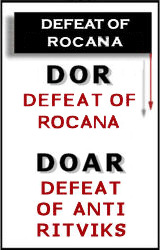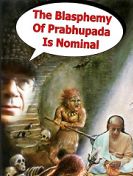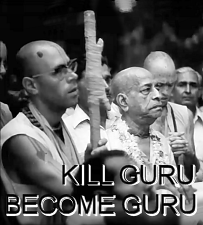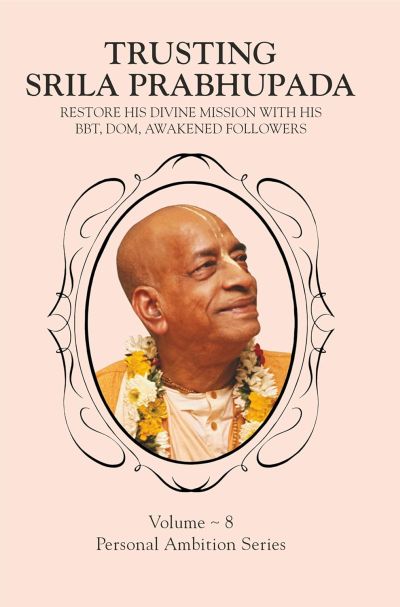httpv://youtu.be/l4OEevxRtBQ
submitted by Yashoda Nandana Prabhu
sri-rupa, sanatana, bhatta-raghunatha
sri-jiva, gopala-bhatta, dasa-raghunatha
SYNONYMS
sri-rupa—Srila Rupa Gosvami; sanatana—Sanatana Gosvami; bhatta-raghunatha—Raghunatha Bhatta Gosvami; sri-jiva—Srila Jiva Gosvami; gopala-bhatta—Gopala Bhatta Gosvami; dasa-raghunatha—Srila Raghunatha dasa Gosvami.
TRANSLATION
The instructing spiritual masters are Sri Rupa Gosvami, Sri Sanatana Gosvami, Sri Bhatta Raghunatha, Sri Jiva Gosvami, Sri Gopala Bhatta Gosvami and Srila Raghunatha dasa Gosvami.
Books : Sri Caitanya-caritamrta – 1975 Edition : Cc. Adi-lila : Adi 1: The Spiritual Masters : Adi 1.36 :
mathurate pathaila rupa-sanatana
dui sena-pati kaila bhakti pracarana
SYNONYMS
mathurate—toward Mathura; pathaila—sent; rupa-sanatana—the two brothers Rupa Gosvami and Sanatana Gosvami; dui—both of them; sena-pati—as commanders in chief; kaila—He made them; bhakti—devotional service; pracarana—to broadcast.
TRANSLATION
Lord Caitanya dispatched the two generals Rupa Gosvami and Sanatana Gosvami to Vrndavana to preach the bhakti cult.
PURPORT
When Rupa Gosvami and Sanatana Gosvami went to Vrndavana, there was not a single temple, but by their preaching they were gradually able to construct various temples. Sanatana Gosvami constructed the Madana-mohana temple, and Rupa Gosvami constructed the Govindaji temple. Similarly, their nephew Jiva Gosvami constructed the Radha-Damodara temple, Sri Gopala Bhatta Gosvami constructed the Radha-ramana temple, Sri Lokanatha Gosvami constructed the Gokulananda temple, and Syamananda Gosvami constructed the Syamasundara temple.
In this way, many temples were gradually constructed. For preaching, construction of temples is also necessary. The Gosvamis not only engaged in writing books but also constructed temples because both are needed for preaching work. Sri Caitanya Mahaprabhu wanted the cult of His sankirtana movement to spread all over the world. Now that the International Society for Krishna Consciousness has taken up this task of preaching the cult of Lord Caitanya, its members should not only construct temples in every town and village of the globe but also distribute books that have already been written and further increase the number of books.
Both distribution of books and construction of temples must continue side by side in parallel lines.
Books : Sri Caitanya-caritamrta – 1975 Edition : Cc. Adi-lila : Adi 7: Lord Caitanya in Five Features : Adi 7.164
tanra madhye rupa-sanatana–bada sakha
anupama, jiva, rajendradi upasakha
SYNONYMS
tanra—within that; madhye—in the midst of; rupa-sanatana—the branch known as Rupa-Sanatana; bada sakha—the big branch; anupama—of the name Anupama; jiva—of the name Jiva; rajendra-adi—and Rajendra and others; upasakha—their subbranches.
TRANSLATION
Among these branches, Rupa and Sanatana were principal. Anupama, Jiva Gosvami and others, headed by Rajendra, were their subbranches.
PURPORT
In the Gaura-ganoddesa-dipika, verse 195, it is said that Srila Jiva Gosvami was formerly Vilasa-masjari gopi. From his very childhood Jiva Gosvami was greatly fond of Srimad-Bhagavatam. He later came to Navadvipa to study Sanskrit, and, following in the footsteps of Sri Nityananda Prabhu, he circumambulated the entire Navadvipa-dhama. After visiting Navadvipa-dhama he went to Benares to study Sanskrit under Madhusudana Vacaspati, and after finishing his studies in Benares he went to Vrndavana and took shelter of his uncles, Sri Rupa and Sanatana.
This is described in the Bhakti-ratnakara. As far as our information goes, Srila Jiva Gosvami composed and edited at least twenty-five books. They are all very celebrated, and they are listed as follows: (1) Hari-namamrta-vyakarana, (2) Sutra-malika, (3) Dhatu-sangraha, (4) Krnnarca-dipika, (5) Gopala-virudavali, (6) Rasamrta-sena, (7) Sri Madhava-mahotsava, (8) Sri Sankalpa-kalpavrkna, (9) Bhavartha-sucaka-campu, (10) Gopala-tapani-tika, (11) a commentary on the Brahma-samhita, (12) a commentary on the Bhakti-rasamrta-sindhu, (13) a commentary on the Ujjvala-nilamani, (14) a commentary on the Yogasara-stava, (15) a commentary on the Gayatri-mantra, as described in the Agni Purana, (16) a description of the Lord’s lotus feet derived from the Padma Purana, (17) a description of the lotus feet of Srimati Radharani, (18) Gopala-campu (in two parts) and (19-25) seven sandarbhas: the Krama-, Tattva-, Bhagavat-, Paramatma-, Krnna-, Bhakti- and Priti-sandarbha.
After the disappearance of Srila Rupa Gosvami and Sanatana Gosvami in Vrndavana, Srila Jiva Gosvami became the acarya of all the Vainnavas in Bengal, Orissa and the rest of the world, and it is he who used to guide them in their devotional service. In Vrndavana he established the Radha-Damodara temple, where we had the opportunity to live and retire until the age of sixty-five, when we decided to come to the United States of America.
When Jiva Gosvami was still present, Srila Krnnadasa Kaviraja Gosvami compiled his famous Caitanya-caritamrta. Later, Srila Jiva Gosvami inspired Srinivasa Acarya, Narottama dasa Thakura and Duhkhi Krnnadasa to preach Krnna consciousness in Bengal. Jiva Gosvami was informed that all the manuscripts that had been collected from Vrndavana and sent to Bengal for preaching purposes were plundered near Vinnupura, in Bengal, but later he received the information that the books had been recovered.
Sri Jiva Gosvami awarded the designation Kaviraja to Ramacandra Sena, a disciple of Srinivasa Acarya’s, and to Ramacandra’s younger brother Govinda. While Jiva Gosvami was alive, Srimati Jahnavi-devi, the pleasure potency of Sri Nityananda Prabhu, went to Vrndavana with a few devotees. Jiva Gosvami was very kind to the Gaudiya Vainnavas, the Vainnavas from Bengal. Whoever went to Vrndavana he provided with a residence and prasada. His disciple Krnnadasa Adhikari listed all the books of the Gosvamis in his diary.
The sahajiyas level three accusations against Srila Jiva Gosvami. This is certainly not congenial for the execution of devotional service. The first accusation concerns a materialist who was very proud of his reputation as a great Sanskrit scholar and approached Sri Rupa and Sanatana to argue with them about the revealed scriptures. Srila Rupa Gosvami and Sanatana Gosvami, not wanting to waste their time, gave him a written statement that he had defeated them in a debate on the revealed scriptures. Taking this paper, the scholar approached Jiva Gosvami for a similar certificate of defeat, but Jiva Gosvami did not agree to give him one.
On the contrary, he argued with him regarding the scriptures and defeated him. Certainly it was right for Jiva Gosvami to stop such a dishonest scholar from advertising that he had defeated Srila Rupa Gosvami and Sanatana Gosvami, but due to their illiteracy the sahajiya class refer to this incident to accuse Srila Jiva Gosvami of deviating from the principle of humility.
They do not know, however, that humility and meekness are appropriate when one’s own honor is insulted but not when Lord Vinnu or the acaryas are blasphemed. In such cases one should not be humble and meek but must act. One should follow the example given by Sri Caitanya Mahaprabhu. Lord Caitanya says in His Siknantaka (3):
trnad api sunicena
taror ivasahinnuna
amanina manadena
kirtaniyah sada harih
“One can chant the holy name of the Lord in a humble state of mind, thinking himself lower than the straw in the street. One should be more tolerant than a tree, devoid of all sense of false prestige, and should be ready to offer all respect to others.
In such a state of mind one can chant the holy name of the Lord constantly.” Nevertheless, when the Lord was informed that Nityananda Prabhu was injured by Jagai and Madhai, He immediately went to the spot, angry like fire, wanting to kill them.
Thus Lord Caitanya has explained His verse by the example of His own behavior. One should tolerate insults against oneself, but when there is blasphemy committed against superiors such as other Vainnavas, one should be neither humble nor meek; one must take proper steps to counteract such blasphemy.
This is the duty of a servant of a guru and Vainnavas. Anyone who understands the principle of eternal servitude to the guru and Vainnavas will appreciate the action of Sri Jiva Gosvami in connection with the so-called scholar’s victory over his gurus, Srila Rupa and Srila Sanatana Gosvami.
Another story fabricated to defame Srila Jiva Gosvami states that after compiling Sri Caitanya-caritamrta, Srila Krnnadasa Kaviraja Gosvami showed the manuscript to Jiva Gosvami, who thought that it would hamper his reputation as a big scholar and therefore threw it into a well. Srila Krnnadasa Kaviraja Gosvami was greatly shocked, and he died immediately.
Fortunately a copy of the manuscript of Sri Caitanya-caritamrta had been kept by a person named Mukunda, and therefore later it was possible to publish the book. This story is another ignominious example of blasphemy against a guru and Vainnava. Such a story should never be accepted as authoritative.
According to another accusation, Srila Jiva Gosvami did not approve of the principles of the parakiya-rasa of Vraja-dhama and therefore supported svakiya-rasa, showing that Radha and Krnna are eternally married. Actually, when Jiva Gosvami was alive, some of his followers disliked the parakiya-rasa of the gopis.
Therefore Srila Jiva Gosvami, for their spiritual benefit, supported svakiya-rasa, for he could understand that sahajiyas would otherwise exploit the parakiya-rasa, as they are actually doing at the present. Unfortunately, in Vrndavana and Navadvipa it has become fashionable among sahajiyas, in their debauchery, to find an unmarried sexual partner to live with to execute so-called devotional service in parakiya-rasa.
Foreseeing this, Srila Jiva Gosvami supported svakiya-rasa, and later all the Vainnava acaryas also approved of it. Srila Jiva Gosvami was never opposed to the transcendental parakiya-rasa, nor has any other Vainnava disapproved of it. Srila Jiva Gosvami strictly followed his predecessor gurus and Vainnavas, Srila Rupa Gosvami and Sanatana Gosvami, and Srila Krnnadasa Kaviraja Gosvami accepted him as one of his instructor gurus.
Books : Sri Caitanya-caritamrta – 1975 Edition : Cc. Adi-lila : Adi 10: The Trunk, Branches and Subbranches of the Caitanya Tree : Adi 10.85







Speak Your Mind